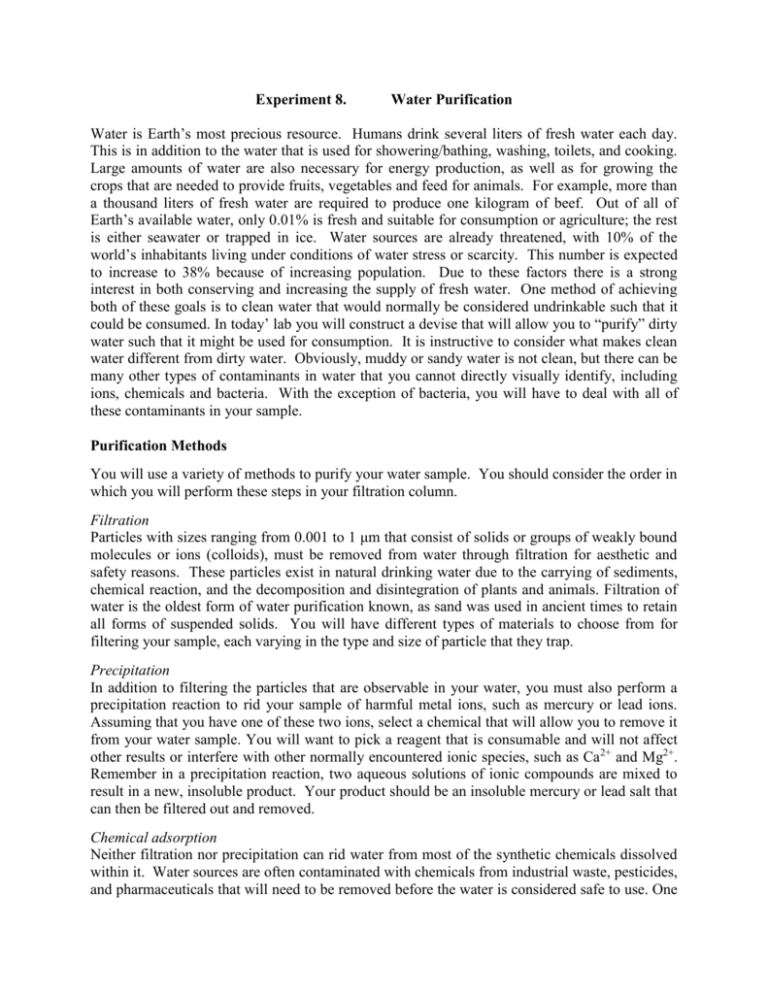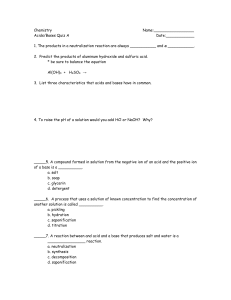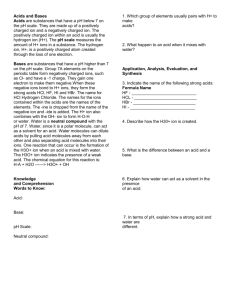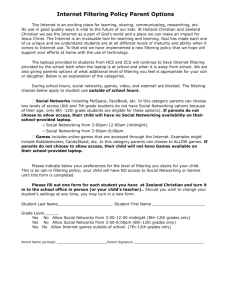Lab 8: Water Purification
advertisement

Experiment 8. Water Purification Water is Earth’s most precious resource. Humans drink several liters of fresh water each day. This is in addition to the water that is used for showering/bathing, washing, toilets, and cooking. Large amounts of water are also necessary for energy production, as well as for growing the crops that are needed to provide fruits, vegetables and feed for animals. For example, more than a thousand liters of fresh water are required to produce one kilogram of beef. Out of all of Earth’s available water, only 0.01% is fresh and suitable for consumption or agriculture; the rest is either seawater or trapped in ice. Water sources are already threatened, with 10% of the world’s inhabitants living under conditions of water stress or scarcity. This number is expected to increase to 38% because of increasing population. Due to these factors there is a strong interest in both conserving and increasing the supply of fresh water. One method of achieving both of these goals is to clean water that would normally be considered undrinkable such that it could be consumed. In today’ lab you will construct a devise that will allow you to “purify” dirty water such that it might be used for consumption. It is instructive to consider what makes clean water different from dirty water. Obviously, muddy or sandy water is not clean, but there can be many other types of contaminants in water that you cannot directly visually identify, including ions, chemicals and bacteria. With the exception of bacteria, you will have to deal with all of these contaminants in your sample. Purification Methods You will use a variety of methods to purify your water sample. You should consider the order in which you will perform these steps in your filtration column. Filtration Particles with sizes ranging from 0.001 to 1 μm that consist of solids or groups of weakly bound molecules or ions (colloids), must be removed from water through filtration for aesthetic and safety reasons. These particles exist in natural drinking water due to the carrying of sediments, chemical reaction, and the decomposition and disintegration of plants and animals. Filtration of water is the oldest form of water purification known, as sand was used in ancient times to retain all forms of suspended solids. You will have different types of materials to choose from for filtering your sample, each varying in the type and size of particle that they trap. Precipitation In addition to filtering the particles that are observable in your water, you must also perform a precipitation reaction to rid your sample of harmful metal ions, such as mercury or lead ions. Assuming that you have one of these two ions, select a chemical that will allow you to remove it from your water sample. You will want to pick a reagent that is consumable and will not affect other results or interfere with other normally encountered ionic species, such as Ca2+ and Mg2+. Remember in a precipitation reaction, two aqueous solutions of ionic compounds are mixed to result in a new, insoluble product. Your product should be an insoluble mercury or lead salt that can then be filtered out and removed. Chemical adsorption Neither filtration nor precipitation can rid water from most of the synthetic chemicals dissolved within it. Water sources are often contaminated with chemicals from industrial waste, pesticides, and pharmaceuticals that will need to be removed before the water is considered safe to use. One of the best methods of achieving this is through the use of activated carbon or charcoal. Every granule of activated carbon has an immense surface area compared to its volume and is able to adsorb (adhere) to chemicals through van der Waals dispersion forces. Assessment of the Purification Process For water to be considered drinkable, it must pass a number of stringent chemical tests. You will perform some of these same tests on your water sample to determine its purity. pH The acidity of a solution is based on the molarity of the hydronium [H3O+] in a solution. The pH of a solution is a measure of its acidity and is given by the negative log of the hydronium ion concentration. pH = -log[H3O+] Scientists use the pH scale instead of the hydronium ion concentration because it is easier to express. Highly acidic solutions, such as lemon juice, have [H+] values around 110-2 M, or in pH units, 2. Solutions that have a low hydronium ion concentration have a high hydroxide ion concentration, [OH-], and are basic. Household ammonia has a pH of 12, a [H3O+] concentration of 110-12 and a [OH-] of 110-2. The relationship between [H3O+] and [OH-] is that [H3O+][OH-] = 110-14 at 25oC. Odor The human olfactory sense is surprisingly capable of detecting certain chemicals in low concentrations. The minimum amount of chemical that must be present to be smelled, the “odor threshold”, is 5 ppm for ammonia. In other words humans are capable of smelling ammonia as long as there are at least 5 ammonia molecules in a sample of 1 million total molecules. For methyl mercaptan, the chemical added to natural gas such that leaks can be noticed, the odor threshold is 0.002 ppm, or 2 molecules out of a billion. Conductivity Substances that dissociate to form ions (or ionize) in solution are known as electrolytes. Different substances dissolve in water to different extents, and substances that dissolve almost completely as ions are called strong electrolytes. For example, NaCl is a strong electrolyte because it readily dissociates into Na+ ions and Cl- ions, whereas a substance like sucrose, C12H22O11, may dissolve, but not as an ion. Strong electrolytes have the capability of allowing electric current to pass through a solution. Although drinking water does, and should, contain ions, it may be harmful to have too many ions. Use the conductivity meter to assess how your ion concentrations change as you run your samples. MATERIAL (3 to 4 participants per group) 1 water filtering system structure Cheesecloth Rubber bands 3 filtration materials (aquarium gravel, sand, activated carbon, marbles, cotton balls, coffee filters, marbles, styrofoam) pH paper 1 metric ruler 1 stirring rod 3 clear plastic cups with a hole punched below rim 3 paper plates 1 graduated cylinder (shared) 500 mL of clean water 500 mL of gray water Procedure 1. Place the 2-L bottle upside down with its mouth over the clear plastic cup to catch the filtered water. 2. Choose three materials to layer in your water filter, and as a group, decide the order in which to layer your materials. 3. Use the ruler to measure 5-8 cm from the screw top opening of the bottle. This will indicate how much filtering material to place into the container. Continue using the ruler to measure the 5-8 cm depth of each layering material. 4. Fill the bottle with the first filtering material to a depth of 5-8 cm. (Pack down coffee filters and cotton balls if you use these materials.) 5. Place the second filtering material to a depth of 5-8 cm on top of the first one. 6. Place the third filtering material to a depth of 5-8 cm on top of the second material. 7. Obtain 350 mL of clean water. Observe the properties before you filter it. Collect and record data. a. Use the wafting technique to smell the water. b. Use your stirring rod to obtain a drop of water, and test its pH using the pH paper and the accompanying color chart. c. Use the conductivity meter to determine if the water conducts electricity. 8. Run clean water through your water filtering system. 9. Draw and label your diagram to match your filtration system. 10. Once the clean water has gone through the water filtering system, test the water again as above. When finished, dispose of the water in the sink unless it is sandy. In this case, separate the sand from the water, dumping the water down the sink and depositing the sand in the appropriate container. 11. Obtain 350 mL of gray water. Observe the properties before you filter it. Collect and record data. a. Use the wafting technique to smell the water. b. Use your stirring rod to obtain a drop of water, and test its pH using the pH paper and the accompanying color chart. c. Use the conductivity meter to determine if the water conducts electricity. 12. The gray water contains a metal ion that you need to remove using a precipitation reaction. You should decide when in the next series of steps that this precipitation will take place. Your only requirement is that the metal ions are eliminated from the final filtered solution. 13. Pour the gray water into the water filtering system. Observe the properties of the water after it has been filtered. Collect and record data. a. Use the wafting technique to smell the water. b. Use your stirring rod to obtain a drop of water, and test its pH using the pH paper and the accompanying color chart. c. Use the conductivity meter to determine if the water conducts electricity. 14. Replace the clear plastic cup with a new one. Pour the collected filtered water back into the filtering system. 15. While the gray water is running through the water filtering system, discuss in your group how each layer in your filtration system affected the gray water. 16. Observe the properties of the water after it has been filtered for the second time. Collect and record the data. a. Use the wafting technique to smell the water. b. Use your stirring rod to obtain a drop of water, and test its pH using the pH paper and the accompanying color chart. c. Use the conductivity meter to determine if the water conducts electricity. PRE-LAB QUESTIONS 1. The hydronium ion concentration of solution A is twice that of solution B which has a pH of 2.4. What is the pH of solution A? 2. The odor threshold for vinyl chloride is 3 parts per thousand. Out of a million molecules, how many vinyl chloride molecules would be necessary to smell this gas? 3. Which of the following substances are not strong electrolytes? For the ones that are not, explain why. HCl NaBr HF NaC2H3O2 C6H6 DATA AND RESUTLS Properties Odor Clean Water Before After Before Gray Water After 1st After 2nd Appearance pH Conductivity Layer 1 Layer 2 Layer 3 QUESTIONS 1. What happened to the water as it passed through the different layers of the filter? What changes occurred to the properties of the gray water as it was filtered? 2. Compare your filtered water to the clean water. Did your gray water become “clean?” What properties told you it was or was not “clean?” 3. If you could build a water filtering system by using any of the materials available in class, which three materials would you use and in what order would you layer them? Why?








